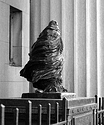Wayne, the Hydroquinone would be part of a specially formulated developer, not part of some bleach. There are two common ways to achieve selective tanning:
PS: I have never done this process, so I would be the very last one to be asked for sample recipes. Ned's blog appears to be what you should be looking at, and the two links I provided in this thread point towards HQ based tanning developers which have at least been tried.
- Use any developer to develop the image, then use a bleach which tans gelatin wherever metallic silver was bleached. That's the approach chosen by the process using the dichromate bleach.
- Use a developer which tans gelatin wherever development takes place. This is what Pyrogallol, Catechol, and apparently also Hydroquinone based developers can do, if they are formulated correctly. No bleach should be necessary here as long as the developer creates sufficient tanning.
I did a fairly meaningless experiment last night, just to see what happened and to use up some old stock. Using the hydroquinone/sodium carbonate version of Pyrocat-HD linked to above, I took 175 ml of Part a and 250 ml Part B and added 500 ml water. My rationale if you can call it that was just to get in the ballpark of 10grams HQ and 40-50 grams carbonate/liter just to make sure I got an image with the least time wasted. I don't know what amounts would be desirable for best tanning. I only made 2 test strips and one "final" print. I was pretty darned pleased with the image, but as expected the solution oxidized rapidly in the tray turning almost black in 15 minutes. I used Oriental RC paper, which isnt suitable for bromoil but seemed adequate for this quick experiment to see if I could get a useable print developer. Anywho I got apretty nice warm toned image with good contrast that was overall quite pleasing, but a fair bit of general stain too on the borders. I'm not sure if a couple grams of sulfite would have reduced the general stain or prolonged its life, but I knew any more than that would prevent image stain so I didn't add any. I'm not sure if this method has any actual potential but I was bored and needed to get rid of some solutions before heading away from my darkroom for a month or two.









